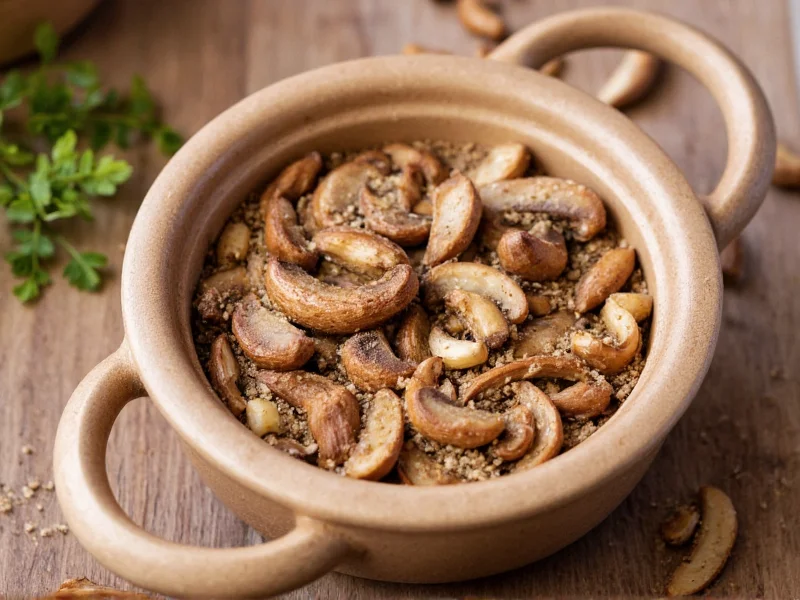What Exactly Is Mushroom Seasoning?
Mushroom seasoning represents one of the most versatile umami boosters in modern cooking. Unlike single-ingredient mushroom powder, true mushroom seasoning typically combines dried mushroom varieties with complementary ingredients that amplify savory depth. The primary components include:
| Component | Purpose | Common Examples |
|---|---|---|
| Dried Mushrooms | Base flavor and umami source | Porcini, shiitake, morel, chanterelle |
| Salt | Flavor enhancer and preservative | Sea salt, kosher salt |
| Umami Boosters | Amplify savory characteristics | Nutritional yeast, tomato powder |
| Anti-Caking Agents | Maintain powder consistency | Rice flour, calcium silicate |
The Science Behind Mushroom Seasoning's Flavor Impact
Mushrooms naturally contain high levels of glutamic acid and guanylate compounds that trigger umami taste receptors. When dried and ground, these compounds concentrate significantly—porcini mushrooms, for instance, develop up to five times more guanylate during dehydration. This natural glutamate concentration explains why mushroom seasoning delivers such potent flavor enhancement without MSG.
Chefs specializing in plant-based cuisine particularly value mushroom seasoning for creating depth in vegetarian and vegan dishes. The seasoning effectively replaces meat-based stocks while providing authentic earthy notes that complement root vegetables, grains, and legumes. Understanding how to use mushroom seasoning in soups and stews separates amateur cooks from professionals—adding it early in the cooking process allows flavors to meld, while finishing dishes with a light sprinkle provides brighter mushroom notes.
Practical Culinary Applications
Mushroom seasoning shines across multiple cooking techniques. For sautéing vegetables, sprinkle 1/4 teaspoon per pound before cooking to create a flavor foundation. When making sauces or gravies, incorporate 1/2 teaspoon per cup of liquid during reduction. The seasoning dissolves completely, unlike mushroom powder which may leave texture.
One frequently asked question involves mushroom seasoning vs msg comparisons. While both enhance umami, mushroom seasoning provides complex flavor notes beyond simple savory enhancement. It contains naturally occurring vitamins and minerals from the mushrooms themselves, including B vitamins and selenium, making it a more nutritionally complete option.
Nutritional Profile and Health Considerations
A teaspoon of mushroom seasoning typically contains:
- 5-10 calories
- 1-2% daily value of potassium
- Trace amounts of B vitamins
- 100-200mg sodium (varies by brand)
Unlike many commercial seasonings, quality mushroom seasoning contains no artificial preservatives or colors. Those monitoring sodium intake should seek low-salt varieties or make homemade versions. The question is mushroom seasoning healthy generally receives positive answers from nutritionists when consumed in moderation as part of balanced cooking.
Creating Superior Homemade Mushroom Seasoning
Producing your own mushroom seasoning ensures maximum freshness and customization. Follow this professional method:
- Select high-quality dried mushrooms (porcini provide deepest flavor)
- Grind to fine powder using a dedicated spice grinder
- Sift through fine mesh to remove coarse pieces
- Mix with complementary ingredients (see ratios below)
The ideal homemade mushroom seasoning recipe balances earthiness with supporting flavors:
- 1/4 cup mushroom powder
- 2 tablespoons nutritional yeast
- 1 tablespoon onion powder
- 1 teaspoon garlic powder
- 1/2 teaspoon sea salt (optional)
- 1/4 teaspoon black pepper
Store in an airtight container away from light and moisture. Properly stored, homemade mushroom seasoning maintains peak flavor for 6-8 months. Commercial products typically last 12-18 months but lose potency over time.
Expert Tips for Maximizing Flavor Impact
Professional chefs employ several techniques to maximize mushroom seasoning's potential:
- Rehydrate before use: Mix with small amount of warm water to activate flavor compounds
- Layer applications: Add during cooking AND finish dishes with light sprinkle
- Balance acidity: Counteract with small amount of acid (lemon juice or vinegar)
- Combine with fats: Mix with olive oil or butter before adding to dishes
Understanding mushroom powder seasoning uses extends beyond simple substitution. It transforms vegetable stocks, enhances grain pilafs, and creates depth in bean dishes without meat. For those exploring vegetarian mushroom seasoning alternatives, combining mushroom seasoning with tomato powder and roasted seaweed creates remarkably meat-like complexity.











 浙公网安备
33010002000092号
浙公网安备
33010002000092号 浙B2-20120091-4
浙B2-20120091-4